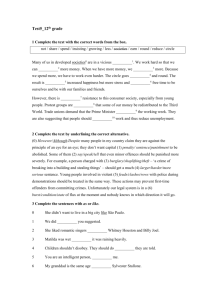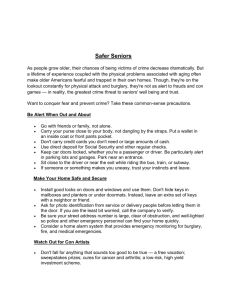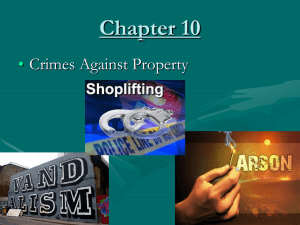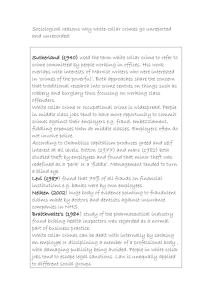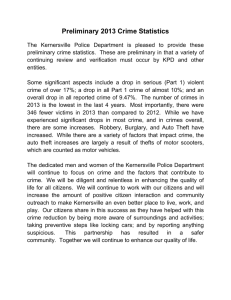Burglary
advertisement
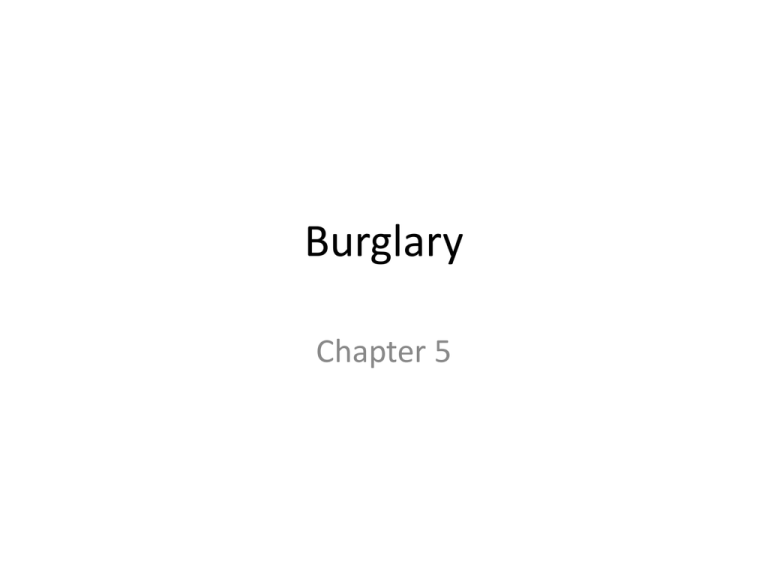
Burglary Chapter 5 Non-violent Economic Crimes Definitions – wide variety of criminal activity, little in common • Common attributes: Do not typically involve aggression, but do involve dehumanization of victims; avoid direct confrontation Economic crimes: acquisition of money & material goods or illegal destruction of property for material gain Tremendous range & scope of offences Focus: burglary/B&E; theft including shoplifting & MV theft; fraud & identity theft; white collar & occupational crime Prevalence: property crimes = 47% of all CC offences in 2007 Property Crimes Offence Number of Offences (2007) Percentage of Property Offences Breaking & Entering 230,920 21.09 MV Theft 146,142 13.34 Theft over 17,369 1.58 Theft under 579,211 52.91 Possession of stolen goods 32,775 2.09 Fraud 88,286 8.06 1,094,703 99.97 Total property offences 2007 Robbery (violence) 29,600 Forcible confinement/kidnap 4,505 Arson 13,202 Counterfeiting currency 55,517 Prostitution 4,724 Property Crime • Common crime • Less dramatic & often less interesting • Far more important than violent crime in the lives of most of us (violation) • Lack of physical aggression or violence in the perpetration of the act itself – Violence may be a by-product Property Crimes • Primarily carried out for purpose of improving one’s economic status • Burglary (B & E in Canada) unlawful entry, with or without force, intent to commit crime (Different from robbery) Characteristics of Burglary Residential property Close to 60% typically steal portable, expensive, compact items When? Daytime (residential) Night & weekends (commercial) Summer months Who? Primarily young males (lazy) • Most offenders will NOT be caught; low-risk is strong motivator BUT..... http://youtube.com/watch?v=c3aYZQJZ1SQ Target Selection Situational cues “close to home” Greatest gain for least effort Occupancy cues (day versus night) Visual cues Wealth cues Layout cues Security cues (house & community) Cognitive Processes • Most burglaries planned though appear opportunistic Cognitive scripts Mental images and plans of how one will act and react in certain situations More you rehearse a script, more habitual it becomes • Solo versus partner: over ½ work with accomplice • Use of alcohol other substances: varying findings What Happens to the “Stuff”? • Fence, pawnshop, acquaintance, Internet, personal use, trade Motives • • • • • Mainly financial gain (supplement income) Alcohol or drugs (addiction or courage?) Opportunity Peer influence (approval?) Adaptive behaviour – Instrumental and strong reinforcement – Low risks & high rewards • May reflect need for fun and excitement Classifying Offenders • Not a homogeneous group Male, unemployed, socially deprived Minimize, neutralize, deny, and justify their actions to themselves and others More prolific Impact of Burglary • “intimate strangers” • Burglar may intend to produce response – Stress and fear: distress levels of victims high • A sense of trust being violated – Reduce by target hardening: occupancy, neighbours, burglar alarms, dogs, deadbolts, locking windows & doors http://www.youtube.com/watch?v=ZyrpPguSKDE • So why don’t people always report it? Are We More Ambivalent/Tolerant of Property Crimes? • Require different psychological explanations: – More emphasis on reinforcements, expectations, justifications, & motivations • Relative deprivation often cited – Disparity between have & want to have/likely to achieve • Cognitive motivators must be considered: – Self-reinforcements & self-justifications including tendency of offenders to minimize, distort or deny misconduct (especially when no direct contact between offender & victim) The Costs? • A very large majority of the general population is victimized in a variety of ways by such crime • If not victimized directly, then the prices of retail goods are affected by shoplifting, cybercrime, and employee theft • Insurance rates are influenced by crimes like auto theft and burglary What About? • Motor vehicle theft? • Shoplifting? • White collar & occupational crime?
